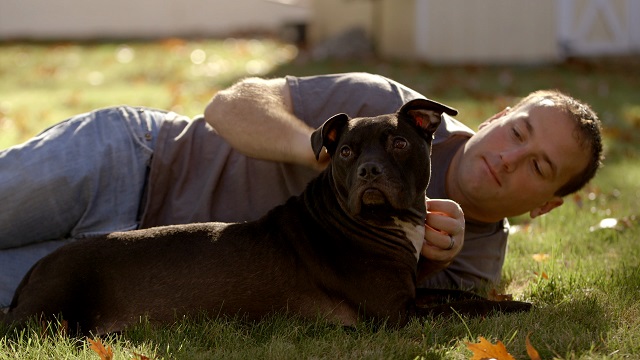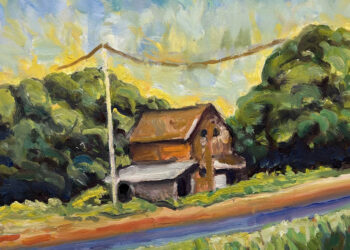This year the Hamptons International Film Festival (HIFF) will debut Compassion, Justice & Animal Rights, a new HIFF Signature Program that takes a look at this significant movement on film. One of the featured films is “The Champions,” which tells the incredible story of the courageous group of people who rescued, rehabilitated, and adopted the pit bulls from NFL quarterback Michael Vick’s violent dog-fighting ring.
We caught up with “The Champions” Director Darcy Dennett to discuss the perseverance of the inspiring dogs featured in “The Champions,” animal welfare, breed restrictions, and the misconceptions about pit bulls.
Why did you feel that this was a story that needed to be told?
I was the series producer for National Geographic’s “DogTown,” so I was on the ground when the Michael Vick dogs were first rescued. We followed their arrival at Best Friends Animal Society for a number of months but the series came to an end after 2 1/2 years, and when we stopped filming, only one of the dogs had gone to an adoptive home. So it was really just the beginning of the story. I went on to other work and sort of kept track on what was happening with the dogs overtime and just became increasingly aware that we had only told the beginning part of the dogs’ story, and hadn’t really gotten a chance to tell more of the story. I just knew there was an amazing story waiting to be told and just couldn’t stop thinking about it. Eventually, I decided I had to make an independent film about them.
At what point did you start documenting the story for the film?
I knew there was a lot of footage that we had shot during the course of “DogTown,” so we licensed some of that material. Being the series producer and director, I knew exactly what existed, so that was helpful. We started pre-production for the project about two years ago. I used some stock footage that the families had filmed, some home footage, to bridge the gap. Then I picked up with filming the dogs where they are now about two years ago. We just finished the film in spring of this year. We filmed most of the story about where the dogs are last year.
 |
|
Paul and Cherry. (Photo: Firefly Filmworks) |
Did you know any of the people that adopted the animals before you started the documentary?
Yes, I knew most of them before I started filming the documentary. A few I didn’t. I knew the people that had adopted Handsome Dan. I knew the people that had adopted Cherry because we had filmed with them throughout the course of “DogTown.” And the others I didn’t know because they had adopted the dogs after “DogTown” had ended, so I reached out to them, and spoke with them, learned more about what was happening with the dogs now. We followed four dogs throughout the course of “DogTown,” so I knew their stories incredibly well already, although we had only scratched the surface.
How familiar with the breed [pit bull] were you before the documentary?
Because of “DogTown” I know more about dogs than many people probably ever will know about dogs, all kinds of breeds. Pit bulls are technically not considered a breed, they’re a mix really of a number of types of breeds. We certainly covered some stories about pit bulls throughout the course of making “DogTown,” and we did a 90 minute special, “Saving the Michael Vick Dogs,” for “DogTown.” That was dedicated exclusively to them, so I was pretty well versed in the subject of pit bulls, even then. That gave me a pretty good background to understand how to contextualize the story that I wanted to tell in “The Champions,” but I certainly learned even more about pit bulls than I knew before. I learned a lot more about how the press has really been demonizing pit bulls as a breed since the 70s and the breeds that are demonized over time really sort of have changed historically. That’s a very interesting thing that I didn’t really know much about until I started working on the film. The “Sports Illustrated” cover from 1987 with the pit bull baring its teeth, that was really the time period where pit bulls really started getting a bad rep by the press, and I think that has really stuck and snowballed since then.
With the Michael Vick case, I had no idea about the extent of violence. Was there anything that shocked you while researching the documentary?
Yes, the USDA report that we were careful about what we selected to shoot in that segment of the film. I didn’t really want to make a film where I was going out to throw Michael Vick under the bus, the film is really supposed to be about the dogs. But it’s obviously hard not to talk about Michael Vick when making a film about the dogs rescued from him. Reading through the USDA investigative report, it’s pretty shocking what’s in there and what the media chose not to report. There were multiple witnesses in that account, and many of the things that these eyewitness recount match up. There’s a segment where Michael Vick talks about what he has admitted to and what he hasn’t, but the things that are in that publicly available report are shocking.
 |
|
Susan Weidel with Little Red. (Photo: Firefly Filmworks) |
I was not aware of breed restrictions before watching “The Champions.”
Breed restrictions are probably more pervasive than most people would imagine. The film’s going to be screening in Denver, which I’m really, really pleased with because Denver has incredibly strict breed bans against pit bulls, as does Miami. I live in New York City and there are definitely places where pit bulls aren’t allowed. Landlords don’t have to allow pit bulls. Recently, a friend of mine knew that I worked on this film and he reached out to me because someone he knew was getting divorced and losing his home and he had a pit bull. He was going to have to be in shelters for some time and what then was going to happen to his pit bull? And the answer is: that dog is going to get euthanized because many places don’t allow pit bulls. Unless you’re in a position where you own your own apartment or have been lucky enough to find a place that allows pit bulls, you may not be able to own that breed. Homeowners policies don’t always cover pit bulls. I was shooting in Rhode Island early in the film and Rhode Island was considering whether or not dogs rescued from fighting rings were automatically defined as vicious. So this kind of legislation is happening all over the country. It’s definitely changing and there are people that are actively working on changing the legislature. Best Friends have lawyers that work on it actively, because it’s not always defined as pit bulls that are “bully breeds.” It can be whatever a homeowners organization wants to define it as.
How did Mark Buehrle become involved in the film?
Mark Buehrle and his wife Jamie’s dog Slater is obviously not a dog rescued from Michael Vick’s dog fighting ring and Slater has never been involved in dog fighting. He’s just a pit bull who was abandoned at a shelter where Jamie adopted him. I wanted to tell a breed discrimination story. We had spoken to this woman in New Llano, Louisiana, who had to move there because her husband got a job in the military, they were posted in New Llano, only to realize that pit bulls weren’t allowed there. The authorities were threatening to take their dog away, so they had to put him in a kennel that was about an hour away from their home, for months. They didn’t have a lot of money and they had to hire a lawyer to try and get the town to change their position. They didn’t want to participate in the film because they were worried it would put their ability to get their dog back in jeopardy and they wanted to focus on making sure they could get their dog back in a place that was safe. Since then, they’ve moved from New Llano just to keep their dog. The reason that the Buehrle story appealed to me was for a different reason. There’s someone like the Buehrles, who are very wealthy, famous (Mark Buehrle is one of the few pitchers who have pitched a perfect game, so he’s very successful), and even the Buehrles weren’t able to get around breed discrimination. They couldn’t live in Miami [because of a breed ban], and when they had no choice but to move to Toronto where Mark was traded, pit bulls are banned throughout Ontario. Mark travels quite a bit during the course of the year, so their situation is already challenging, and they have younger children, so Jamie and the family has chosen for Jamie and the kids to live in St. Louis where they’re both from, rather than travel with Mark as he plays, so that they can keep their dog. Jamie can’t even charter a plane to go visit Mark that will agree to fly their dog. The financial success that they’ve had doesn’t make their issue any easier.
Did you hope with this film that you would dispel myths about dogs that are caught in dog fighting rings?
In the past, as the film suggests, dogs rescued from fighting situations were always euthanized. They were considered evidence. They were presumed to be dangerous and aggressive. The hope would be that the film would show that dogs rescued from fighting ring situations are victims, who have been brutalized. My hope would be that this would not only change people’s point of view of dogs rescued from fighting situations, but also pit bulls in general, and also on animals in generals. They’re individuals, each one is completely different. They respond to a situation like the trauma that they all experienced collectively at Michael Vick’s dog fighting ring completely differently, and that they all deserve to be evaluated as individuals and to be given a chance. I hope this film completely changes the way that people see a pit bull when they walk by one on the street.
 |
|
Meryl and Brooklyn. (Photo: Firefly Filmworks) |
Best Friends seemed to play a huge role in the film. How well did you know the organization before filming?
Best Friends was exclusively featured in “DogTown,” which focused on Best Friends’ work with dogs at their sanctuary in Utah. So I spent 2 ½ years working with them. I knew them extraordinarily well. I had a very trusting pre-existing relationship with them. Animal rescue organizations are really guarded about their work. They were willing to open their doors and trust me. Their main concern is to change the public perception of pit bulls because there are so many euthanized across the country. They’re one of the most euthanized dogs across the country.
Watching the growth of the dogs was absolutely astonishing.
One of the other inspirations for the story was this dog, Cherry, who’s featured in the film and we covered extensively during the making of “DogTown.” I personally filmed Cherry when he first arrived at the sanctuary and would literally refuse to walk and was so shut down he couldn’t even look at a person. That lasted for months, if not years. I am a Best Friends supporter and almost every year I walk my dog along the Hudson during an event that Best Friends has called Strut Your Mutt, to help raise funds for them. I saw this black pit bull that was wagging its tail, surrounded by a bunch of people, and I look up and I realized that’s Paul and Melissa, who I recognized as the people that adopted Cherry at the very end of “DogTown.” I just started to cry because I could not believe, even when I see Cherry now, I often will get very emotional because I cannot believe this dog was capable of such huge change. Most people say that people don’t change, yet here’s this dog that’s come from this horrific situation, who with a leap of faith, time, love and care over this period of time was able to get over his past and find joy and happiness in this adoptive home. It’s really inspiring. I find it amazing that these dogs have been able to transition in the way that they have. These dogs now have fans all of the country.
“The Champions” will screen at HIFF on Saturday, October 10th at 1:30 p.m. at the United Artists East Hamptons Cinema 2 Theater (30 Main Street, East Hampton) with a Special Panel following the screening at 3:30 p.m. “The Champions” will also screen on Monday, October 12th at 11 a.m. at the Sag Harbor Cinema (90 Main Street, Sag Harbor).
For more information about the Hamptons International Film Festival screenings, visit hamptonsfilmfest.org. For more information about “The Champion,” visit www.championsdocumentary.com.












